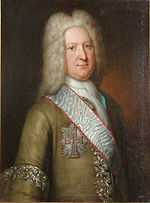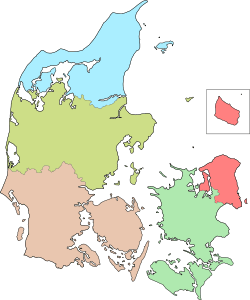Regions of Denmark
The Regions of Denmark were created as part of the 2007 Danish Municipal Reform. The five regions replace the former counties (amter). At the same time, the number of municipalities (kommuner) was cut from 270 to 98. The reform was made effective on 1 January 2007.
Unlike the counties, which they replaced to a large extent, the regions are not municipalities and therefore do not have the right to display coat of arms, but they do have logotypes. They do not themselves levy any taxes, but are financed partly by a tax levied by the central government and partly by the municipalities.
List of regions
The names of the regions in English are not uniform. The government often uses the Danish names[1] or directly translated English names (e.g. Greater Copenhagen, Zealand, North Jutland, Southern Denmark, Central Jutland).[2] The regions themselves partially use other names in English, substituting 'Jutland' for 'Denmark', as shown below.
| Danish name | English name | Seat of administration | Largest city | Chairman | Population (2012-01-01) | Area (km²) | Pop. density (per km²) | Corresponding counties (1970–2006) |
|---|---|---|---|---|---|---|---|---|
| Region Hovedstaden | Capital Region of Denmark | Hillerød | Copenhagen | Vibeke Storm Rasmussen | 1,714,486 | 2,546.3 | 673.32 | Copenhagen County and Frederiksborg, and the municipalities of Copenhagen, Frederiksberg and Bornholm |
| Region Midtjylland | Central Denmark Region | Viborg | Aarhus | Bent Hansen | 1,266,682 | 13,000.2 | 97.44 | Ringkjøbing, nearly all of Århus, the southern part of Viborg and the northern part of Vejle |
| Region Nordjylland | North Denmark Region | Aalborg | Aalborg | Ulla Astman | 579,996 | 7,874.0 | 73.66 | North Jutland, the northern part of Viborg County and a small part of Århus County |
| Region Sjælland | Region Zealand | Sorø | Roskilde | Jens Stenbæk | 817,907 | 7,217.8 | 113.32 | Roskilde, Storstrøm, and West Zealand |
| Region Syddanmark | Region of Southern Denmark | Vejle | Odense | Carl Holst | 1,201,342 | 12,191 | 98.02 | Funen, Ribe, South Jutland and the southern half of Vejle County |
| Danmark | Denmark | Copenhagen | Copenhagen | - | 5,580,413 | 42,894.8 | 130.10 |
Tasks
The most important area of responsibility for the new regions is the public health service. They are also responsible for employment policies and public mass transit (buses and a few local railways). However, in eastern Denmark (Region Zealand and the Capital Region) transit is handled by a single transport agency, Movia.
Administration and politics
Regions are led by directly elected councils (regionsråd). They consist of 41 members each. Elections are held simultaneously with municipal elections every four years. The last Danish local elections were held on 19 November 2013.
Unlike the former counties, regions are not entitled to levy their own taxes. Thus, the present regions rely entirely on central state funding (around 70%) and funding coming from the municipalities (around 30%). A central government "health contribution" tax (sundhedsbidrag) at 8.00% on the preliminary and final income statement forms has replaced the county tax (amtsskat).
90% of the budgets of the regions are allocated to the national health service. Health issues have remained the primary hot issue in regional politics, especially because grand changes of Denmark's hospital layout were announced immediately after the municipal reform.
History
The reform has been called the biggest reform in thirty years. It was an important policy issue for the former Liberal-Conservative cabinet, most importantly for Lars Løkke Rasmussen, then minister of the Interior and Health.
The abolition of the counties had long been an important goal for both the Conservatives and the Danish People's Party. In June 2004, the Danish People's Party decided to back the reform, thus securing a majority in the Danish parliament (Folketing), although the party had preferred just abolishing the counties without replacing them with a new intermediate administrative level (the other two being the central government and the municipalities). The parties who wanted to limit the regional tier of government prevailed insofar as the regions have no authority to levy any taxes, unlike the former counties.
State administrations
The 5 state administrations (statsforvaltning) are the representations of the central government in the five regions. They belong to The Ministry of the Interior and Health. Their jurisdictions follow the regional borders. These administrations are not subordinate to the regional councils, but rather the direct presence of the state (similar to governorates or prefectures in certain countries).
A state administration office exists in each region, supervising the daily business of municipalities and regions, and functioning as a body of appeal for citizens who wish to complain over a decision by the municipality or region. The offices also handle affairs concerning adoption, citizenship and divorces.
Each office is led by a Director of the State Administration (forvaltningsdirektør) who is a university graduate of law.
History

The predecessor of the state administrations, before the 2007 reform, were the state counties (statsamt). In Copenhagen Municipality the prefecture was called the 'Upper Presidium' (Københavns Overpræsidium). Each of these were led by a governmental civil servant, the county prefect ((stats)amtmand). In Copenhagen he was called the 'Lord President' (Københavns overpræsident), a title dating from 1747, but not widely known by the public. In some counties the prefect also performed the duty of overseeing the financial administration of the church as a diocesal county prefect (stiftamtmand), also being a part of the diocesan authorities within the National Church.
The county prefect was also the political leader of county councils until the first municipal reform of 1970, when this task was taken over by the county mayor (amtsborgmester) who was one of the elected county council members. In Copenhagen Municipality, the switch was made in 1938 when the title of Lord Mayor (overborgmester) was created.
With the notable exception of cases concerning i.e. divorce and child custody, the general public are not acquainted with what goes on in the prefectures (from 1970) or the 5 State Administrations (from 2007). Also, the county prefect in his uniform would be the person to receive the Queen on her visits throughout the country.
See also
- Municipalities of Denmark
- Subdivisions of the Nordic countries
- Faroe Islands
- Greenland
- ISO 3166-2:DK
References
- ↑ E.g. [Statistics Denmark] in the Statistical Yearbook 2009, page 32
- ↑ English names of state administrations
External links
- Danish Ministry for Economic Affair and the Interior - Statistics department Statistical information about Danish regions and municipalities (Danish)
- Explanation of and background for Municipal Reform – with links to the Danish Ministry of the Interior and Health (English)
- The agreement on the Municipal Reform – from the Danish Ministry of the Interior and Health (Danish)
- The Ministry´s home page with report from the Commission on Administrative Structure etc.
- Home page of Regions. Click on map to access a Region's home page (Danish)
- Budget of the Regions(Danish)
- Statistikbanken.dk Budget
- Statistikbanken.dk Budget(Danish)
- English home page of State Administrations
- Areas of concern (adoption etc.) (English)
- Ministry of Employment
- Links to the 4 employment regions(Danish)
- Regionalization and devolution: Proposed new regions of Norway (powerpoint slide show)
- Maps (pdf) showing local/regional administration 1660-2007(Danish)
- Map with named municipalities and regions
- Krak searchable/printable map(outline of municipality visible, but does not print out!)
- Statistics Denmark
| ||||||||||||||||||||||||||||||||||||||||||
| |||||||||||

